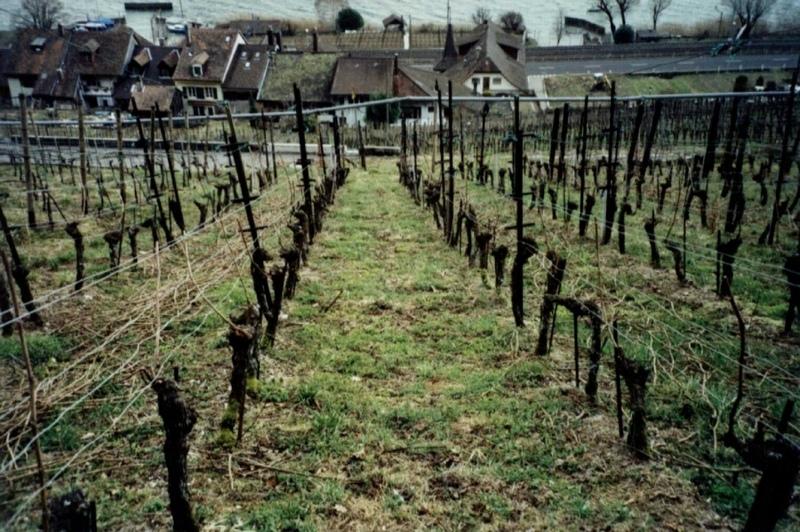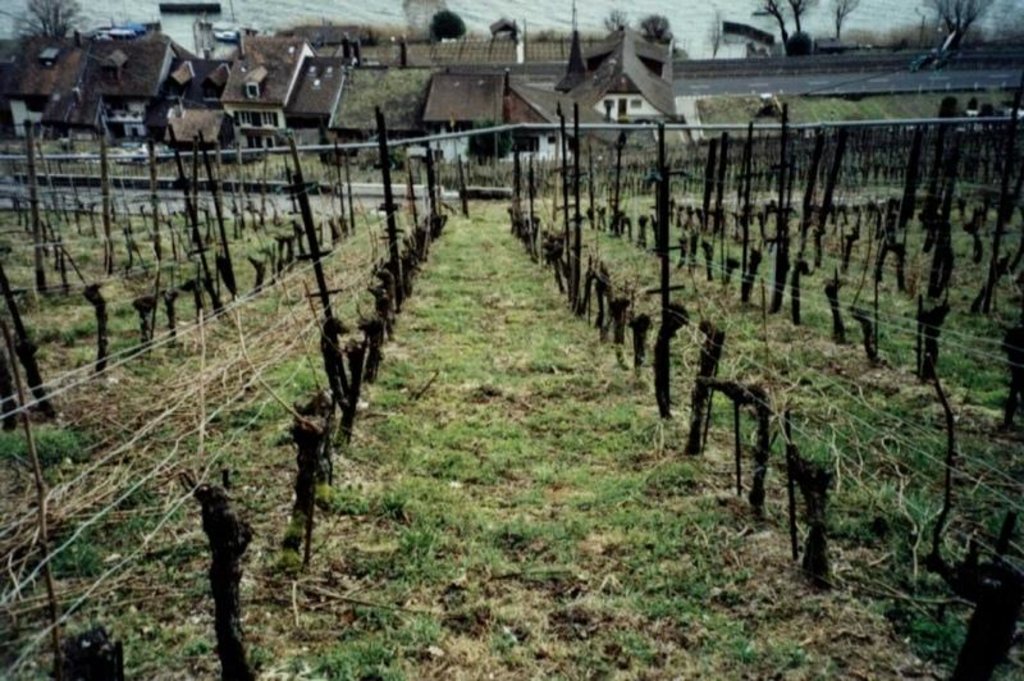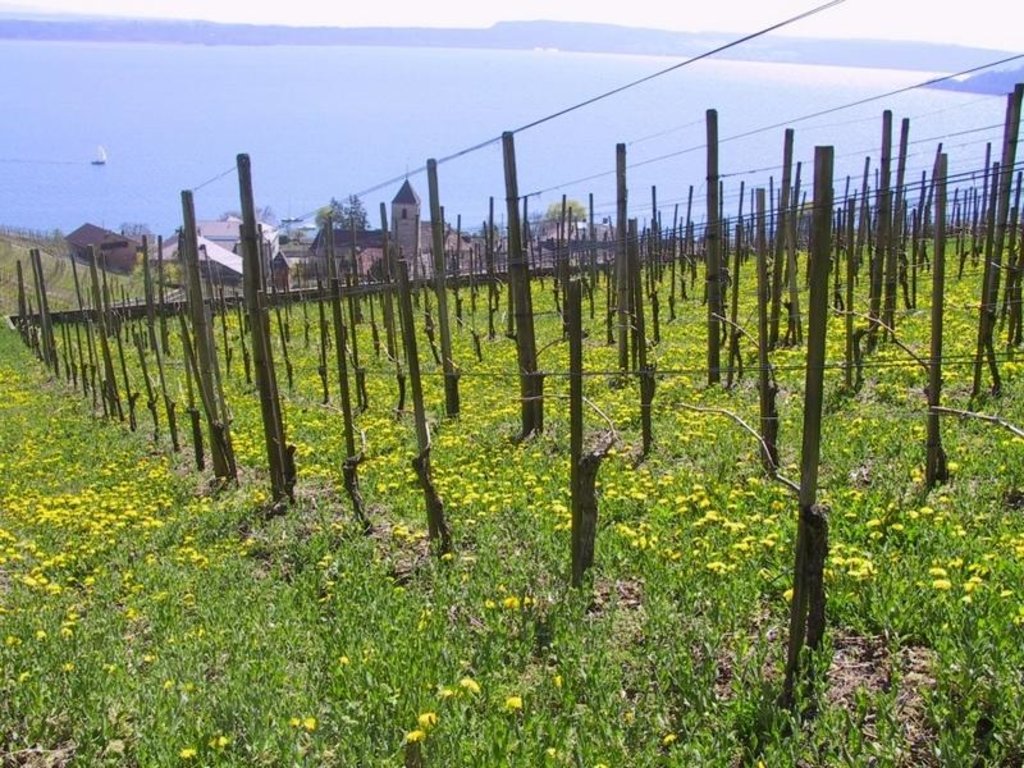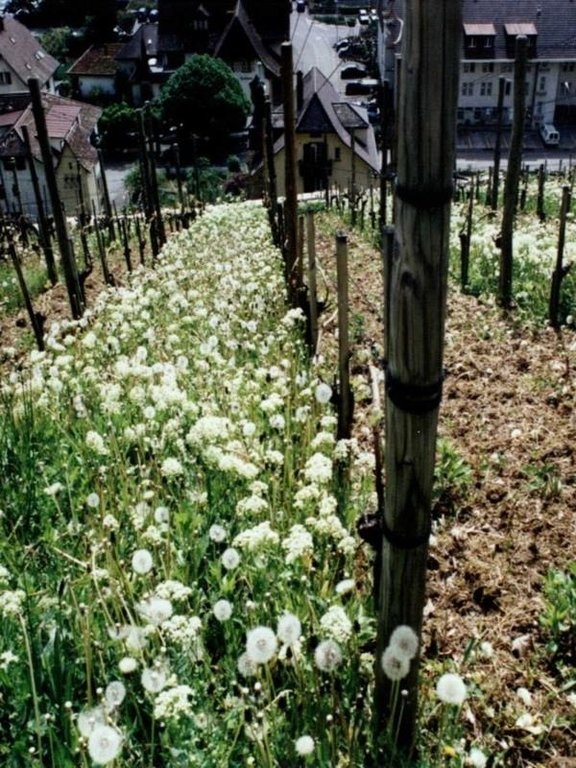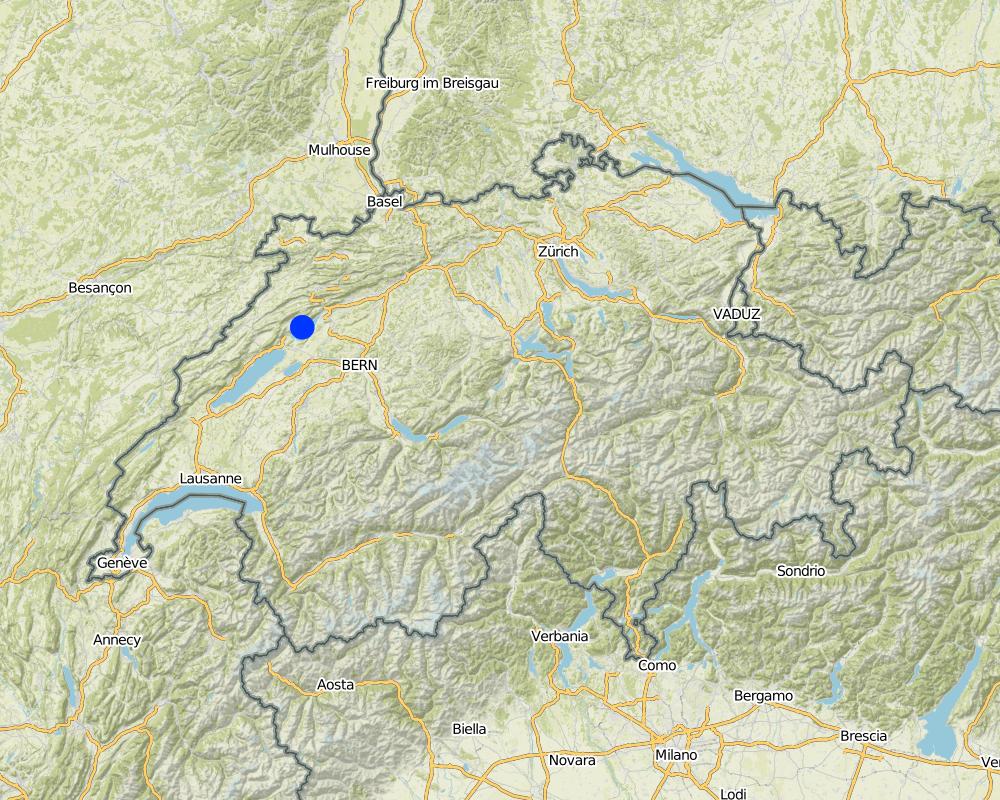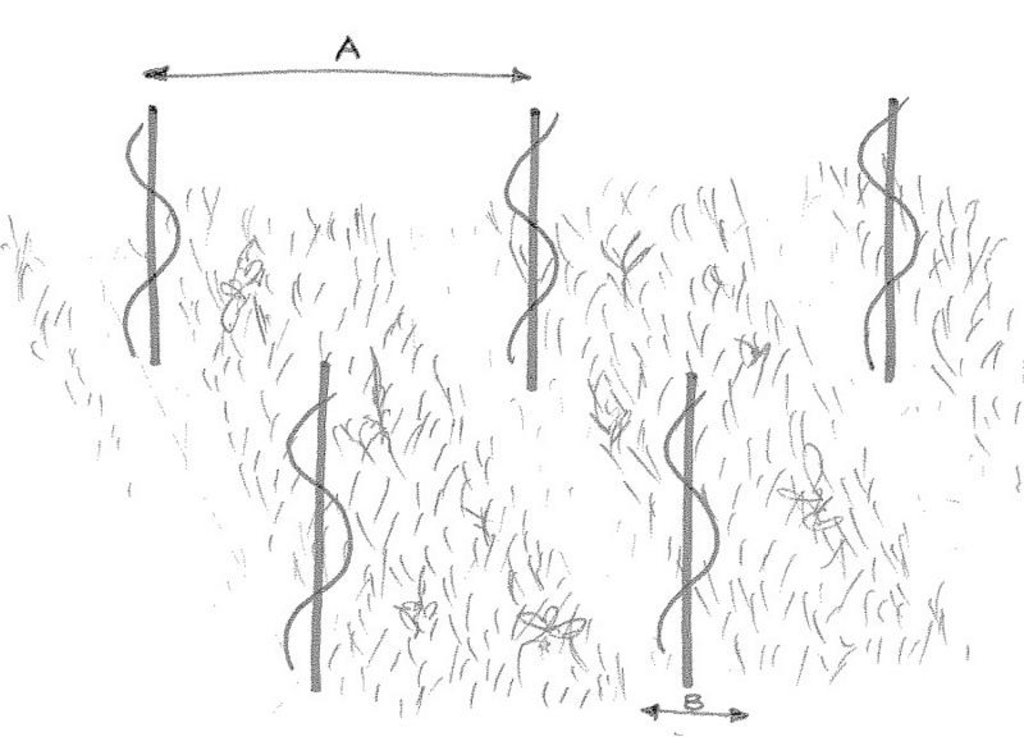Green cover in vineyards [瑞士]
- 创建:
- 更新:
- 编制者: Nicole Guedel
- 编辑者: –
- 审查者: Fabian Ottiger, Deborah Niggli
Begrünung von Rebflächen (im Direktzug / in der Falllinie bewirtschaftet)
technologies_1018 - 瑞士
查看章节
全部展开 全部收起1. 一般信息
1.2 参与该技术评估和文件编制的资源人员和机构的联系方式
SLM专业人员:
Weissenbach Peter
+41 (0)43 783 61 11
info@faw.admin.ch
Federal Research Station for fruit-growing, viticulture and horticulture -FAW
Postfach 185, 8820 Wädenswil, Switzerland
瑞士
SLM专业人员:
Spring Jean-Laurent
+41(0)22 363 44 44
info@rac.admin.ch
Federal Research Station for fruit-growing, viticulture and horticulture-RAC
CP 254 1260 Nyon 1, Switzerland
瑞士
土地使用者:
Louis Hannes
+41 (32) 315 14 41
johannes.louis@schafiser.com
Louis Weinbau
Schafisweg 37a, 2514 Schafis, Switzerland
瑞士
土地使用者:
Hasler Lukas
Hasler Weinbau
Moos 43, 2513 Twann, Switzerland
瑞士
有助于对技术进行记录/评估的项目名称(如相关)
Book project: where the land is greener - Case Studies and Analysis of Soil and Water Conservation Initiatives Worldwide (where the land is greener)有助于对技术进行记录/评估的机构名称(如相关)
Federal Research Station for fruit-growing, viticulture and horticulture (FAW/RAC) - 瑞士有助于对技术进行记录/评估的机构名称(如相关)
CDE Centre for Development and Environment (CDE Centre for Development and Environment) - 瑞士1.3 关于使用通过WOCAT记录的数据的条件
(现场)数据是什么时候汇编的?:
01/10/2003
编制者和关键资源人员接受有关使用通过WOCAT记录数据的条件。:
是
1.5 请参阅有关SLM方法的问卷
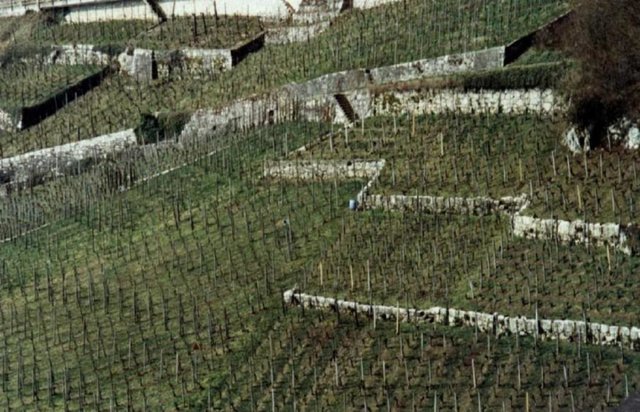
Farmer initiative within enabling environment [瑞士]
Initiative and innovation of land users, stimulated by government's technical and financial support.
- 编制者: Nicole Guedel
2. SLM技术的说明
2.1 技术简介
技术定义:
Naturally growing or sown perennial grasses/herbs providing cover
between rows in sloping vineyards, where the vines are usually oriented up and down slope.
2.2 技术的详细说明
说明:
The area around Lake Biel has a strong wine growing tradition dating back several centuries. The vineyards are, for micro-climatic reasons, sited on the southwest facing slope close to the lake. Annual rainfall is about 1,000 mm, with at least one erosive storm per year, and the soils are highly erodible. In conventional viniculture all weeds are controlled chemically. The ‘green cover technology’ comprises sown, or naturally occurring, perennial grasses and herbs which form a biodiverse green cover - a ‘living mulch’ - over the soil surface between vine rows. In this region, rows are generally oriented up and down the slope for ease of machine operation. Green cover may also be applied where vines are grown on narrow bench terraces. The purpose is the prevention of soil degradation, especially soil erosion by water. Secondary purposes include protection of the soil surface from compaction when using mechanised equipment, and promotion of biodiversity.
Green cover is generally established naturally - except on contour-planted terraced vineyards, where cover is planted for immediate stabilisation of the terraces. To avoid competition, a 10-40 cm diameter zone around the freshly planted vines is kept free from vegetation: during the three year establishment period it is removed by hoe, later it is controlled with herbicides (either as a strip along vine rows or around individual vines). The topsoil between the vine rows is ripped every few years with an implement pulled by a small caterpillar tractor. The green cover vegetation is cut, chopped and left as mulch several times using special mulching machines. These operations are not carried out over the whole field at once: alternate rows are left untouched to ensure that some vegetation remains to maintain biodiversity. When these rows redevelop their green cover, the others are then treated. This is effectively a minimum tillage system, building up organic matter in the soil. Cutting and mulching, in addition to ripping, serves to circulate nutrients. Mineral fertilizer and herbicides are applied once a year around the vines. Experiments with the technology started in the 1970s, but green cover has now become standard practice.
Supportive measures include not removing crop residues (from vineyards) which are chopped later - simultaneously with the cover crop (grass) - to protect the soil surface, and irrigation in dry years.
2.3 技术照片
2.5 已应用该技术的、本评估所涵盖的国家/地区/地点
国家:
瑞士
区域/州/省:
Canton of Berne
有关地点的进一步说明:
Lake of Biel
注释:
The technology is applied in all wine growing regions of Switzerland, but under different conditions
Map
×2.6 实施日期
如果不知道确切的年份,请说明大概的日期:
- 不到10年前(最近)
2.7 技术介绍
详细说明该技术是如何引入的:
- 通过项目/外部干预
注释(项目类型等):
The development of green cover in vineyards was (also on the international level) essentially promoted and supported by the Federal Research Station for fruit-growing, viticulture and horticulture in Wädenswil (Canton of Zürich)
3. SLM技术的分类
3.2 应用该技术的当前土地利用类型

农田
- 多年一作(非木材)
- 乔木与灌木的种植
主要农作物(经济作物及粮食作物):
Major cash crop perennial tree/shrub cropping: Vine grapes
注释:
Major land use problems (compiler’s opinion): The main problem was decreasing soil fertility, especially through soil erosion by water, caused by lack of soil cover and intensive cultivation. There were associated negative offsite effects including sand/sediment deposition and contamination of groundwater by nutrients. This became a serious problem from the 1960s when the traditional labour-intensive methods were superseded by a mechanised-industrial agricultural system.
Type of cropping system and major crops comments: a vine plantation is established for a period of 20-40 years (lifetime of a vine). Some farmers make one year of fallow between the destruction of the old and the establishment of a new plantation.
3.3 有关土地利用的更多信息
注释:
Water supply: rainfed, mixed rainfed - irrigated
每年的生长季节数:
- 1
具体说明:
Longest growing period in days: 210Longest growing period from month to month: Apr - Oct
3.4 该技术所属的SLM组
- 改良的地面/植被覆盖
- 横坡措施
3.5 技术传播
注释:
The technology is applied in all wine growing regions of Switzerland, but under different conditions. The technology described (SWI01) is based on a case study of one region
3.6 包含该技术的可持续土地管理措施

农艺措施
- A6:其它

植物措施
- V5:其它
注释:
Main measures: agronomic measures, vegetative measures
Specification of other agronomic measures: minimum tillage: cutting & mulching, ripping
Specification of other vegetative measures: cover cropping
Type of agronomic measures: mulching, manure / compost / residues, mineral (inorganic) fertilizers, breaking compacted topsoil
Type of vegetative measures: scattered / dispersed
3.7 该技术强调的主要土地退化类型

土壤水蚀
- Wt:表土流失/地表侵蚀
- Wo:场外劣化效应

化学性土壤退化
- Cn:肥力下降和有机质含量下降(非侵蚀所致)
- Cp:土壤污染

物理性土壤退化
- Pc:压实
- Pk:熟化和结壳
注释:
Main type of degradation addressed: Wt: loss of topsoil / surface erosion, Wo: offsite degradation effects, Cn: fertility decline and reduced organic matter content, Cp: soil pollution
Secondary types of degradation addressed: Pc: compaction, Pk: sealing and crusting
Main causes of degradation: other human induced causes (specify) (agricultural causes: fast changing basic conditions of viticulture in the last 100 years), education, access to knowledge and support services (lack of knowledge), fast changing basic conditions of viticulture (economy, laws)
3.8 防止、减少或恢复土地退化
具体数量名该技术与土地退化有关的目标:
- 减少土地退化
注释:
Main goals: mitigation / reduction of land degradation
4. 技术规范、实施活动、投入和成本
4.1 该技术的技术图纸
4.2 技术规范/技术图纸说明
Technical drawing of green cover on parcel with vine rows oriented up and down the slope. A = distance between vine rows (130-220 cm), B = zone of application of herbicides (10-40 cm).
Location: Twann, Lake of Biel. Canton of Berne
Date: June 2003
Technical knowledge required for field staff / advisors: moderate
Technical knowledge required for land users: moderate
Main technical functions: control of raindrop splash, control of dispersed runoff: retain / trap, improvement of ground cover, improvement of soil structure
Secondary technical functions: increase of surface roughness, increase in organic matter, increase of infiltration, increase / maintain water stored in soil, increase in soil fertility
Mulching
Material/ species: cut or chopped cover vegetation
Remarks: dispersed over the whole surface; if possible cutting/chopping only every second row (alternating)
Agronomic measure: removing less vegetation cover
Material/ species: cut or chopped cover vegetation, vine leaves and cut branches
Remarks: between vine rows
Manure / compost / residues
Material/ species: compost
Remarks: only sporadically (every 5-10 year or less)
Mineral (inorganic) fertilizers
Material/ species: nitrogen
Quantity/ density: 0-50 kg/ha
Remarks: normally rather little nitrogen
Agronomic measure: mineral (inorganic) fertilizers: potassium
Quantity/ density: 0-20 kg
Agronomic measure: mineral (inorganic) fertilizers: magnesium
Quantity/ density: 0-25 kg
Agronomic measure: mineral (inorganic) fertilizers: phosphorus
Quantity/ density: 0-20 kg
Breaking compacted topsoil
Remarks: if possible: only every second row (alternating)
Scattered / dispersed
Vegetative material: G : grass
Grass species: different grass species, taraxacum, veronica, legumes, calystegia, geranium...
4.3 有关投入和成本计算的一般信息
其它/国家货币(具体说明):
Swiss Franc
注明美元与当地货币的汇率(如相关):1美元=:
0.75
4.4 技术建立活动
| 活动 | 措施类型 | 时间 | |
|---|---|---|---|
| 1. | Allow natural cover to establish. | 植物性的 | winter/spring, usually at the same time as a new plantation is established |
| 2. | Weeding around base of vines to reduce competition, 2–4 times during | 植物性的 | during season (Mai – October), 2 - 4 times, when necessary. |
4.5 技术建立所需要的费用和投入
| 对投入进行具体说明 | 单位 | 数量 | 单位成本 | 每项投入的总成本 | 土地使用者承担的成本% | |
|---|---|---|---|---|---|---|
| 劳动力 | Labour | ha | 1.0 | 13800.0 | 13800.0 | 100.0 |
| 设备 | Machine use | ha | 1.0 | 1000.0 | 1000.0 | 100.0 |
| 设备 | Tools | ha | 1.0 | 100.0 | ||
| 植物材料 | Seeds of natural vegetation | ha | 1.0 | 100.0 | ||
| 肥料和杀菌剂 | Fertilizer | ha | 1.0 | 200.0 | 200.0 | 100.0 |
| 肥料和杀菌剂 | Biocides | ha | 1.0 | 100.0 | ||
| 肥料和杀菌剂 | Compost/manure | ha | 1.0 | 100.0 | ||
| 技术建立所需总成本 | 15000.0 | |||||
注释:
Duration of establishment phase: 36 month(s)
4.6 维护/经常性活动
| 活动 | 措施类型 | 时间/频率 | |
|---|---|---|---|
| 1. | cuting and not removing vine leaves and branches | 农业学的 | winter / annual |
| 2. | Apply mineral fertilizer to the vines (particularly K, N, P, Mg) | 农业学的 | April/May / annual |
| 3. | Cut cover vegetation with a portable motor scythe or mower with | 农业学的 | during cropping season (first time April/May) / each row 2-4 times during cropping season |
| 4. | cuting and not removing vine leaves and branches | 农业学的 | during cropping season / several times during cropping season |
| 5. | Minimum tillage (rip topsoil) of alternating inter-rows with machine | 农业学的 | April/May / each row every 4-8 years |
| 6. | Application of herbicides (glyphosates) | 植物性的 | beginning of season (May), if necessary second time in Aug./Sept /once (if necessary twice) during s |
| 7. | Cut/chop vine leaves and wood for mulching | 农业学的 | during growing season, 2-4 times |
4.7 维护/经常性活动所需要的费用和投入(每年)
| 对投入进行具体说明 | 单位 | 数量 | 单位成本 | 每项投入的总成本 | 土地使用者承担的成本% | |
|---|---|---|---|---|---|---|
| 劳动力 | Labour | ha | 1.0 | 1500.0 | 1500.0 | 100.0 |
| 设备 | Machine use | ha | 1.0 | 650.0 | 650.0 | 100.0 |
| 设备 | Tools | ha | 1.0 | 100.0 | ||
| 肥料和杀菌剂 | Fertilizer | ha | 1.0 | 60.0 | 60.0 | 100.0 |
| 肥料和杀菌剂 | Biocides | ha | 1.0 | 90.0 | 90.0 | 100.0 |
| 肥料和杀菌剂 | Compost/manure | ha | 1.0 | 100.0 | ||
| 技术维护所需总成本 | 2300.0 | |||||
注释:
Machinery/ tools: e.g.: hoe, mower with tracked vehicle or portable motor scythe, spading machine with tracked vehicle; knapsack sprayer or biocide tank transported by
Costs are calculated on the basis of vine rows being oriented up and down the slope, a distance between rows of
1.3-2.2 m and 6,500 vines per ha on a slope of <60%. Establishment costs have been estimated and are representative of the situation when green cover is encouraged to establish at the same time as new vines are planted (normal practice). This means that the estimated costs include all the annual agronomic and vegetative inputs within the first 3 years during the establishment phase. If green cover is implemented more than 3 years after planting new vines, establishment costs are much reduced, because the vines are bigger, competition with the green cover is less, and the vines are not so sensitive to herbicides, which permits the replacement of labour intensive manual weeding by application of herbicides. Maintenance costs are based on one typical winegrower in the region. Initial investments in machinery and costs directly attributable to ‘plant capital’ (the vines) are not included.
4.8 影响成本的最重要因素
描述影响成本的最决定性因素:
Labour is the major cost component, since wage levels are very high in Switzerland.
5. 自然和人文环境
5.1 气候
年降雨量
- < 250毫米
- 251-500毫米
- 501-750毫米
- 751-1,000毫米
- 1,001-1,500毫米
- 1,501-2,000毫米
- 2,001-3,000毫米
- 3,001-4,000毫米
- > 4,000毫米
有关降雨的规范/注释:
Average: Biel: 1200 mm. Region of Bielersee: 1000 - 1200 mm. Neuchâtel: 930 mm.
农业气候带
- 半湿润
Thermal climate class: temperate
5.2 地形
平均坡度:
- 水平(0-2%)
- 缓降(3-5%)
- 平缓(6-10%)
- 滚坡(11-15%)
- 崎岖(16-30%)
- 陡峭(31-60%)
- 非常陡峭(>60%)
地形:
- 高原/平原
- 山脊
- 山坡
- 山地斜坡
- 麓坡
- 谷底
垂直分布带:
- 0-100 m a.s.l.
- 101-500 m a.s.l.
- 501-1,000 m a.s.l.
- 1,001-1,500 m a.s.l.
- 1,501-2,000 m a.s.l.
- 2,001-2,500 m a.s.l.
- 2,501-3,000 m a.s.l.
- 3,001-4,000 m a.s.l.
- > 4,000 m a.s.l.
关于地形的注释和进一步规范:
Altitudinal zones: 501-1000 m a.s.l. (For climatic reasons vines grow hardly above 600 m a.s.l. in Switzerland )
Landforms: Hill slopes (most of them southeastward sloping hills (part of the Jura mountain range) )
5.3 土壤
平均土层深度:
- 非常浅(0-20厘米)
- 浅(21-50厘米)
- 中等深度(51-80厘米)
- 深(81-120厘米)
- 非常深(> 120厘米)
土壤质地(表土):
- 中粒(壤土、粉土)
表土有机质:
- 中(1-3%)
如有可能,附上完整的土壤描述或具体说明可用的信息,例如土壤类型、土壤酸碱度、阳离子交换能力、氮、盐度等。:
Soil depth on average: Deep (81-120cm) (Soil depth is very irregular, at some places limestone rocks appear at the surface, at other places soil can be quite deep).
Soil fertility is medium (Vines are normally grown on rather marginal spots. Compared to the general productivity these soils have a medium fertility. (If measured at the vine itself, soil fertility is sufficient/high).
Topsoil organic matter is medium (1-3%) (without / before SWC (green cover)
Soil drainage/infiltration is mostly good, at some points medium (at some spots medium (depressions; when high percentage of clay).
Soil water storage capacity is medium (without / before SWC (green cover)), high (without / before SWC (green cover)) or low (without / before SWC (green cover). Depressions; when high percentage of clay)
5.6 应用该技术的土地使用者的特征
生产系统的市场定位:
- 商业/市场
非农收入:
- 低于全部收入的10%
相对财富水平:
- 平均水平
机械化水平:
- 手工作业
- 机械化/电动
说明土地使用者的其他有关特征:
Population density: 200-500 persons/km2
Annual population growth: 0.5% - 1%
100% of the land users are average wealthy.
Off-farm income specification: This is representative for the full time winegrowers. The majority of winegrowers do winegrowing beside a regular off-farm job (partly 10-50% of income with salary from off-farm work) as a hobby. Nearly all winegrowers have implementeted the SWC technology. Probably there is no difference in hobby-winegrowers and full-time-winegrowers concernring implementation of the SWC technology.
Level of mechanization is manual labour (most of the work in the vineyard is done by hand (especially harvest)) or mechanised (some of the activities are carried out with fuel driven equipment. But mechanisation is moderate since big and heavy machines cannot been applied in these vineyards)
Market orientation is: Commercial/market (in the region of the lake of Biel the majority of grapes are pressed to wine an then and sold directly from the farm's wine cellar)
5.7 应用该技术的土地使用者拥有或租用的平均土地面积
- < 0.5 公顷
- 0.5-1 公顷
- 1-2 公顷
- 2-5公顷
- 5-15公顷
- 15-50公顷
- 50-100公顷
- 100-500公顷
- 500-1,000公顷
- 1,000-10,000公顷
- > 10,000公顷
注释:
Average area of land owned or leased by land users applying the Technology: 0.5-1 ha, 1-2 ha, 2-5 ha (only winegrowing land!)
5.8 土地所有权、土地使用权和水使用权
土地所有权:
- 个人,有命名
土地使用权:
- 租赁
- 个人
6. 影响和结论性说明
6.1 该技术的现场影响
社会经济效应
生产
作物生产
注释/具体说明:
10–20% due to competition for water/nutrients
作物质量
注释/具体说明:
Quality of wine decreased when strong competition of water and nutrients happens and nothing is done against it.
生产故障风险
注释/具体说明:
Due to competition of water and nutrients and higher susceptibility to fungal decay (due to higher evapotranspiration rate with green cover and therefore humid microclimatic conditions). Little danger of frost only in depressions or plains (due to higher evapotranspiration rate)
收入和成本
农业收入
注释/具体说明:
(Indirectly due to less erosion damage in the long-term – also due to subsidies related to green cover,marketing under the label of ‘ecological agricultural production’, and other criteria)
工作量
注释/具体说明:
More and specific knowledge necessary. Weeing, cutting, ripping
其它社会经济效应
Machine use
注释/具体说明:
Special machines needed, mechanisation is almost a must to be economically successful in the long term
社会文化影响
健康状况
注释/具体说明:
Healthier than without SWC, less application of biocides
社区机构
注释/具体说明:
Increased exchange of knowledge and contacts in winegrowers society
国家机构
注释/具体说明:
Research stations gained new knowledge and attention
SLM/土地退化知识
注释/具体说明:
Among winegrowers, but perhaps also slightly among consumers (through an ecological marketing argument) or walkers (walking through a green vineyard may arise interest in green cover).
冲突缓解
注释/具体说明:
Between generations or between farmers applying green cover and others. Reason: farmers are differently attached to traditional values and norms (i.e.: traditionally every plant 'out-of-place' was seen as unuseful weed and fought with a hoe)
Personal satisfaction / challenge
注释/具体说明:
Many farmers apply green cover see green cover as a personal satisfaction or challenge for an ecologically and economically sustainable viticulture
Acceptance by society
注释/具体说明:
Landscape and appearance of vineyard as cultural heritage. Reason: different values an norms of "how a vineyard should look like". Traditionally vines were planted very dense with no vegetation cover in between.
生态影响
土壤
土壤水分
注释/具体说明:
Especially through improved water retention capacity (due to improved soil structure)
土壤覆盖层
土壤流失
土壤压实
生物多样性:植被、动物
外来入侵物种
注释/具体说明:
Especially mice
害虫/疾病控制
注释/具体说明:
Through beneficial animals
其它生态影响
Soil fertility
Biodiversity
Soil erosion through wind
6.2 该技术的场外影响已经显现
下游洪水
下游淤积
注释/具体说明:
And groundwater
地下水/河流污染
风力搬运沉积物
6.4 成本效益分析
技术收益与技术建立成本相比如何(从土地使用者的角度看)?
短期回报:
消极
长期回报:
积极
技术收益与技术维护成本/经常性成本相比如何(从土地使用者的角度看)?
短期回报:
积极
长期回报:
积极
6.5 技术采用
在所有采用这项技术的人当中,有多少人是自发地采用该技术,即未获得任何物质奖励/付款?:
- 90-100%
注释:
10% of land user families have adopted the Technology with external material support
Comments on acceptance with external material support: estimates
90% of land user families have adopted the Technology without any external material support
Comments on spontaneous adoption: estimates
There is a strong trend towards spontaneous adoption of the Technology
Comments on adoption trend: Nearly all of the land users have adopted green cover independently of the direct incentives received for growing vines. The spontaneous spread of green cover occurred before these incentives were tied to ‘ecological production’. Note: Swiss agriculture in general is highly subsidised (see approach).
6.7 该技术的优点/长处/机会
| 土地使用者眼中的长处/优势/机会 |
|---|
|
Personal satisfaction/challenge for ecologically and economically sustainable viniculture How can they be sustained / enhanced? Promote ecologically sustainable agriculture. |
|
Increased exchange of knowledge and contacts in winegrowers’ associations How can they be sustained / enhanced? Sustain/strengthen farmers’ institutions. |
| Improved knowledge/awareness regarding SWC/erosion: among winegrowers, but perhaps also to some extent among consumers (through ecological marketing) or walkers passing by. |
| 编制者或其他关键资源人员认为的长处/优势/机会 |
|---|
|
Prevention of erosion How can they be sustained / enhanced? Maintain green cover |
|
Improvement of soil quality (fertility, organic matter, moisture retention, soil structure) How can they be sustained / enhanced? Ensure that cover vegetation doesn’t compete with the vines; improve soil properties by applying mentioned agronomic measures. |
|
Contribution to a better balanced and more stable ecosystem (with living space for a wider range of organisms) How can they be sustained / enhanced? Specific management of cover crops (alternating treatment of inter-rows; find solutions to replace application of herbicide). |
| In the long-term economically beneficial because of cutting costs of restoration of soils and fertility loss after heavy erosion events. |
| Possibilities of farm income increase through marketing wine under the ‘vinatura’ label, certifying ecologically produced wine. |
6.8 技术的弱点/缺点/风险及其克服方法
| 编制者或其他关键资源人员认为的弱点/缺点/风险 | 如何克服它们? |
|---|---|
| General competition of water and nutrients depending on climate, soil depth and species of cover vegetation | Eliminate/reduce competitive effect of cover vegetation by cutting/mulching vegetation or ripping/ploughing soil. |
| Application of herbicides around vines because of undesirable vegetation in proximity of vine | Find alternative solutions, or minimise application of herbicides. |
链接和模块
全部展开 全部收起链接

Farmer initiative within enabling environment [瑞士]
Initiative and innovation of land users, stimulated by government's technical and financial support.
- 编制者: Nicole Guedel
模块
无模块


